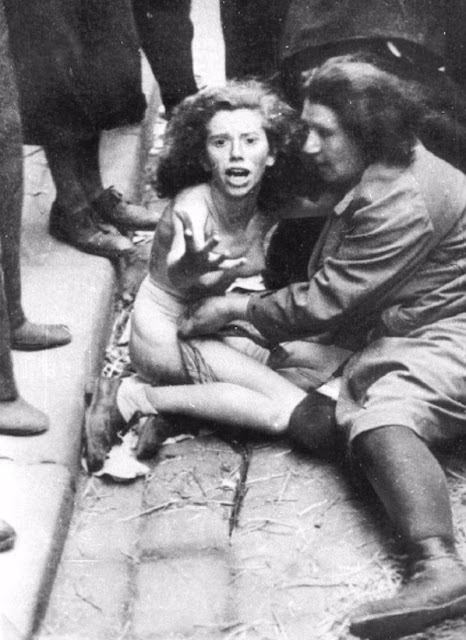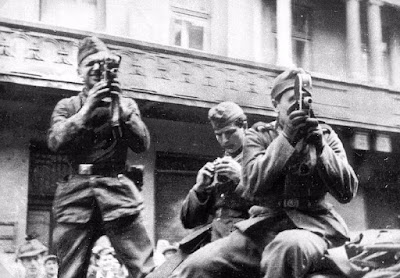First St. Petersburg. Marking the 80th anniversary of the lifting of the Siege of Leningrad, January 27, 1944.
From retired Indian diplomat M. K. Bhadrakumar at his Indian Punchline blog, January 17:
An anniversary West would rather forget
An epochal anniversary from the annals of modern history is coming up in another ten days that remains a living memory for the Russian people. The Siege of Leningrad, arguably the most gruesome episode of the Second World War, which lasted for 900 days, was finally broken by the Soviet Red Army on 27th January 1944, eighty years ago to be exact.
The siege endured by more than three million people, of whom nearly one half died, most of them in the first six months when the temperature fell to 30° below zero. It was an apocalyptic event. Civilians died from starvation, disease and cold. Yet it was a heroic victory. Leningraders never tried to surrender even though food rations were reduced to a few slices of bread mixed with sawdust, and the inhabitants ate glue, rats — and even each other — while the city went without water, electricity, fuel or transportation and was being shelled daily.
It was on the 22nd of June, 1941 that the German armies crossed the Russian frontiers. Within six weeks, the Army Group North of the Wehrmacht, armed forces of the Third Reich, was within fifty kms of Leningrad in a fantastic blitzkrieg and had advanced 650 kms deep into Soviet territory.
A month later, the Germans had all but completed the city’s encirclement, only a perilous route across Lake Ladoga to the east connected Leningrad with the rest of Russia. But the Germans got no further. And 900 days later their retreat began.
The epic siege of Leningrad was the longest endured by any city since Biblical times, and, equally, citizens became heroes — artists, musicians, writers, soldiers and sailors who stubbornly resisted the iron from entering their souls. Petrified by the prospect of surrender to the Soviet Union, the Nazis preferred to lay down arms before the western allied forces, but Gen. Dwight Eisenhower, Supreme Commander of the Allied Expeditionary Force in Europe, ordered that the honour of victory should go to the Red Army.
Herein lies one of the greatest paradoxes of war and peace in modern times. Today, the anniversary of the siege of Leningrad has become, most certainly, an occasion that the US and many of its European allies would rather not remember. Yet, its contemporary relevance is not to be glossed over, either.
The Nazi leadership aimed to exterminate Leningrad’s entire population by enforced starvation. Death by starvation was a deliberate act on the part of the German Reich. In the words of Joseph Goebbels, Adolf Hitler “intended to have cities like Moscow and St Petersburg wiped out.” This was “necessary”, he wrote in July 1941, “because if we want to divide Russia into its individual parts,” it should “no longer have a spiritual, political or economic centre.”....
....MUCH MORE
Part of the early time line via Wikipedia:
- September 22: Hitler issues "Directive No. 1601" ordering "St. Petersburg must be erased from the face of the Earth" and "we have no interest in saving lives of civilian population."
- October: Food shortages cause serious starvation of civilians. Civilian deaths exceed hundreds of thousands by the end of the Autumn. Shostakovich and his family are evacuated to Kuybishev.
- November 8: Hitler's speech in Munich: "Leningrad must die of starvation."
A year later to the day, January 27, 1945, the Soviet Red Army liberated the few remaining victims at the Auschwitz murder factory at Oświęcim, Poland.
This event is commemorated as Holocaust Remembrance Day. As well it should be. From the Washington Post, January 27, 2020:
The first transport of Jews to Auschwitz was 997 teenage girls. Few survived.
But it wasn't just Auschwitz. The second deadliest extermination camp was Treblinka. Between 750,000 and 900,000 were murdered at Treblinka, second only to the ~1.1 million toll at Auschwitz. And because it was not in operation as long as Auschwitz the murder rate was higher at Treblinka, averaging over 1,000 per day for two years, and up to 10,000 on a few days.
And it wasn't just the extermination camps. Some 1.6 million people were shot to death in the so-called Holocaust by Bullets in Lithuania, Belarus and Ukraine. The most famous of these sites is Babyn Yar, Kyiv, Ukraine where 34,000 were shot to death in two days. At Majdanek in Lublin Poland and two smaller camps some 43,000 were shot to death in November 1943's Operation Harvest Festival by the
Rava-Ruska
You could see the pits move, some of them were still alive'
—Daily Mail, August 24, 2015
There are ten thousand places where this happened. And it wasn't just the shooting sites.
As the Germans crossed into the Ukrainian SSR the Ukrainians went nuts on their Jewish neighbors. Then as now they seemed to get off on stripping, humiliating and terrorizing women and girls:

Some of the contemporaneous reports say that she was raped before this picture of her, stripped and terrorized, was taken.
The newly arrived Germans were groovin' on the Ukrainian pogrom action [4000 murdered]:

The Germans had attacked the Soviets on June 22, 1941 and by June 30 had fought their way to Lviv. From the diary [German, English translation] of Felix Landau, SS senior non-commissioned officer just as the Ukrainians were getting going:
Lwow - 5 July 1941... There were hundreds of Jews walking along the street with blood pouring down their faces, holes in their heads, their hands broken and their eyes hanging out of their sockets. They were covered in blood. Some were carrying others who had collapsed. We went to the citadel; there we saw things that few people have ever seen. At the entrance to the citadel there were soldiers standing guard. They were holding clubs as thick as a man's wrist and were lashing out and hitting anyone who crossed their path. The Jews were pouring out of the entrance. There were rows of Jews lying one on top of the other like pigs, whimpering horribly. The Jews kept streaming out of the citadel completely covered in blood. We stopped and tried to see who was in charge of the Kommando. Nobody. Someone had let the Jews go. They were just being hit out of rage and hatred...
That's what is at the core of Holocaust Remembrance Day.